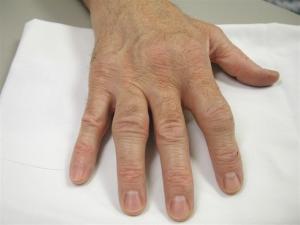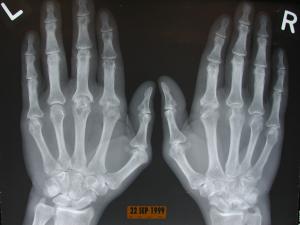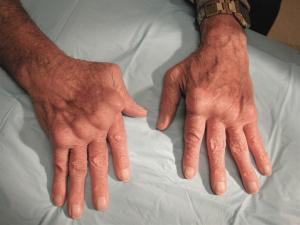Overview
Rheumatoid arthritis (RA) is an autoimmune disorder in which an immune attack against the small joints of the hands and feet occurs due to abnormal targeting of this tissue by the immune system. Those suffering from RA may first experience stiffness and pain in the hands, wrists, and feet and other joints, particularly in the morning.
FAQs
What are the usual symptoms of rheumatoid arthritis?
As the disease progresses one notices swelling in addition to the pain and stiffness. Fluid in the joint can lead to difficulty moving for several hours. Activity generally makes people feel less stiff as the joint fluid is removed by movement in the lymphatic system. A hot shower or bath can also help alleviate some of the symptoms. Over the counter anti-inflammatories like ibuprofen usually provide some relief. Fatigue is also a common symptom for patients with RA due to the inflammatory chemicals called cytokines produced by the immune system that play a role in the swelling and damage to the joint. Some of these cytokines include TNF (tumor necrosis factor) IL-1 (interleukin 1) and IL-6 (interleukin 6).
What causes rheumatoid arthritis?

We now know that genes play an important role in the risk of developing RA and that environmental factors may trigger the events that cause the inflammatory cascade that leads to RA. HLA (human leukocyte antigen) proteins are on all of our cells and help identify cells to the immune system , while also helping the immune system work to protect us. These proteins are inherited from our parents. There is one HLA protein known as HLA DR4 that is found in many people with RA and makes it more likely that someone with this protein will develop the disease. The HLA protein is the most important genetic risk factor for developing RA but over 100 other genes may play a role, including one called PTPN22. PTPN22 was discovered by our very own faculty member, Dr. Tomas Mustelin, who continues to research important questions related to RA at the University of Washington.
The most important environmental risk factor for developing RA is smoking. Smoking can cause inflammation in the lungs that leads to activation of the immune system resulting in the formation of antibodies that cause RA, especially anti-CCP antibodies (cyclic citrullinated antibodies). Anti-CCP antibodies can be present in the circulation for many years before the development of RA. Once anti-CCP antibodies and another antibody called rheumatoid factor (RF) gain access to the joints, inflammation leads to stiffness, pain, swelling, and damage to bone and cartilage.
Who gets rheumatoid arthritis?
Individuals of all ages, including children, can be diagnosed with RA. In adults, women between the ages of 20-60 are most often affected but after age 60 both men and women are equally likely to be diagnosed with RA. Approximately 0.5- 1% of the population in the US and Canada are affected by RA. Native Americans (in the US) and First Nations people (in Canada) have some of the highest prevalence rates for RA for reasons that are still being investigated. In the Division of Rheumatology, Dr. Greg Gardner and Dr. Ingeborg Sacksen travel to several Native American clinics to provide care.
How is rheumatoid arthritis diagnosed?

The diagnosis of rheumatoid arthritis is made after a thorough history (talking to your care provider) and a thorough examination of the joints as well as some key blood tests. Rheumatoid arthritis is an inflammatory form of arthritis meaning it causes stiffness at night and in the morning and the symptoms improve with activity. Your care provider will look for joint tenderness and swelling as well. The joints usually affected include the PIPs and MCPs (joints where your fingers begin and the middle joints). The DIPs (end joints) are not affected by RA for some unknown reason.
Tests are available for the anti-CCP antibodies and RF and if both are present in a high level in the blood the diagnosis of RA is confirmed. There are some people (about 10-20%) who have RA who do not have these antibodies and are called seronegative RA.
X-rays can also be ordered to look for damage. One looks for erosions and joint space narrowing as a sign that the disease is progressing.
Ultrasound can also be used to “see” swelling before one can feel the swelling on examination. Ultrasound uses soundwaves to look for extra blood flow to the joint, fluid, and extra tissue in the joint. Dr. Scott Pollock is a nationally recognized expert in this area and has been very helpful in identifying active disease in people with RA and also confirming that the disease is under good control.
What can happen to a person with RA without proper treatment?
The natural history of RA is progressive damage and deformity to the joints. As cartilage and bone are progressively lost, the fingers also angle to the side in what is called ulnar deviation. It becomes difficult and painful to use the joints and doing such routine activities such as bathing, grooming, and cooking becomes progressively more difficult. Below is an example of joint damage that can be seen in RA. This picture shows the ulnar deviated (toward the ulnar bone on the outside of the wrist) and subluxed (out of place) joints of long-standing RA. The same thing can happen to the feet. In the feet the toes become fibular deviated (toward the fibula or bone on the outside of the leg) and also subluxed. Other joints areas such the cervical spine, shoulders, elbows, wrists, hips, knees, and ankles can also be affected.
 We also know that undertreated people with RA can also have a shorted life span. Data from the 1980’s found that women with active RA that never came under control lost 10 years off of their lives primarily due to early heart disease. Research has found that chronic inflammation leads to early atherosclerosis (hardening of the arteries) that leads to heart attacks. Men in this same data set lost 5 years off of their lives for the same reason. Early effective treatment though can avoid all of the issues described above and the treatment of RA has become one of the great success stories in medicine in the last 30 years. Currently the life expectancy of someone with well treated RA is almost the same as the general population.
We also know that undertreated people with RA can also have a shorted life span. Data from the 1980’s found that women with active RA that never came under control lost 10 years off of their lives primarily due to early heart disease. Research has found that chronic inflammation leads to early atherosclerosis (hardening of the arteries) that leads to heart attacks. Men in this same data set lost 5 years off of their lives for the same reason. Early effective treatment though can avoid all of the issues described above and the treatment of RA has become one of the great success stories in medicine in the last 30 years. Currently the life expectancy of someone with well treated RA is almost the same as the general population.
Can other organs besides the joints be affected by rheumatoid arthritis?
Besides the joints, blood vessels can be inflamed and damaged (rheumatoid vasculitis), one can have eye inflammation (scleritis or inflammation of the lining of the eye and corneal inflammation or inflammation of the outer layer of the eye), tendons can rupture, carpal tunnel can develop, and the lung can also be inflamed and damaged (rheumatoid interstitial lung disease). Many of these complications are much less common than they used to be owing to very effective therapy. The lung though, continues to be problematic for some, especially men with long standing RA. Inflammation and scar tissue can develop in the lower parts of the lung and lead to shortness of breath with activity and, if severe, even when at rest. Early recognition and intervention is important to help avoid damaging lung tissue. Two of our doctors, Dr. Greg Gardner and Dr. Mark Wener work in a dedicated lung clinic that specializes in lung inflammation in people with RA.
How is rheumatoid arthritis treated?
Generally once RA is diagnosed patients are quickly put on medications to control inflammation. This sometimes includes a low dose of prednisone to help the patient feel better while the other medications are taking effect. Most people are started on a medication called methotrexate and the dose increased as tolerated to control the inflammation. Other medications are added to methotrexate as needed to control inflammation with the goal of remission (no symptoms, no swelling). The current program of therapy is early diagnosis, early treatment, and treat until remission. It is important to work with a rheumatologist as well as your primary care provider to control the RA and stay healthy. Below is a list of medications that could be used to treat RA:
Non-biologics
Biologics
- TNF inhibitors: Enbrel, Humira, Cimzia, Remicade, Simponi
- T cell inhibitor: Abatacept
- IL-6 inhibitors: Actemra, Kevzara
- B cell inhibitor: Rituximab
- Jak inhibitors: Xeljanz, Olumiant
A rheumatologist is uniquely qualified to help in the decision making regarding which medications might be most useful. The biologics are very expensive and generally require insurance approval. All these medications require monitoring for side effects and most require blood testing on a regular basis.
In the near future, blood testing will identify which genes or proteins are most active and allow a rheumatologist to choose specific medications based on that information, and so-called precision medicine.
Other Issues
- It is important that a person with RA be up-to-date on immunizations
- RA is a risk factor for osteoporosis so avoiding smoking and excess alcohol is important. Early DEXA screening may be indicated to detect thin bones.
- Given the risk of cardiovascular disease, having your primary care provider look for and address other potential risk factors such as cholesterol, smoking, weight etc., is important
Getting involved
- You can get involved by participating in clinical research. Dr. Bobby Han in the Division of Rheumatology is an expert in clinic trials. If you are interested in participating in a medication trial for RA, review the current trials for your eligibility and contact Megan Tran if interested.
- Review the possible areas where donations would make a difference. Your support is critical to finding answers to cure this disease. Click here to make a gift.



